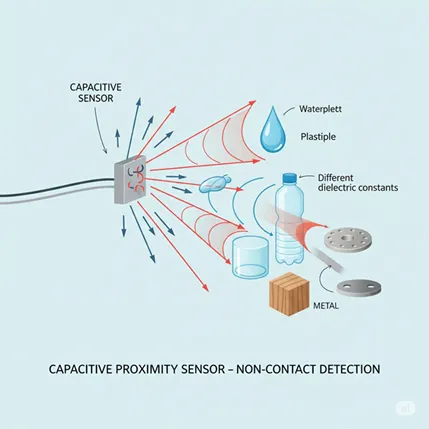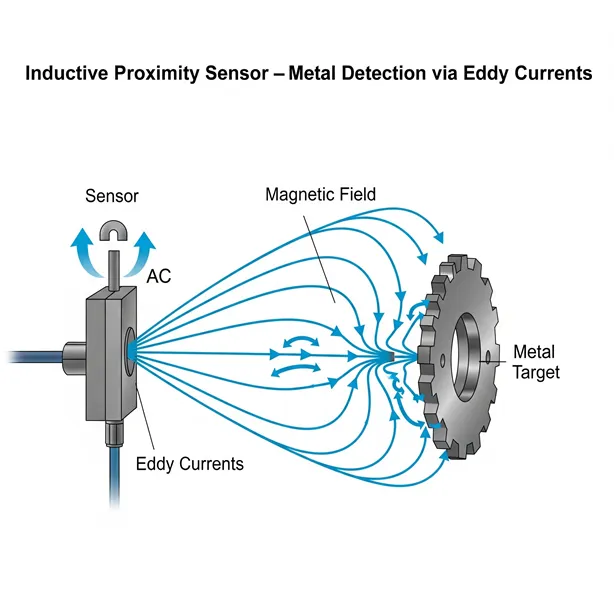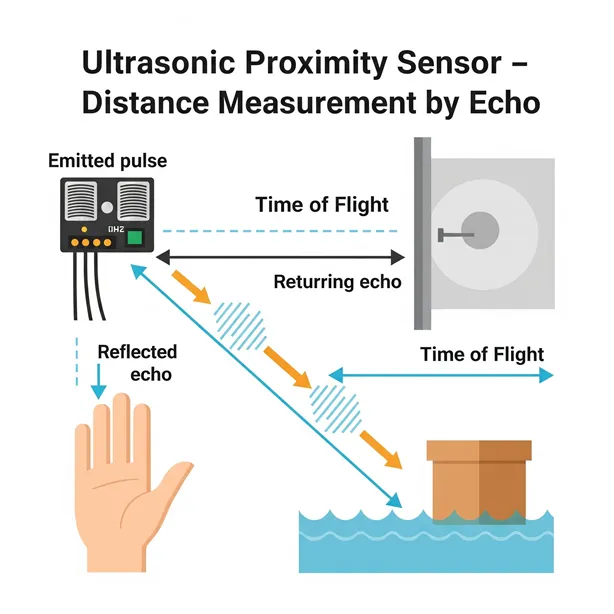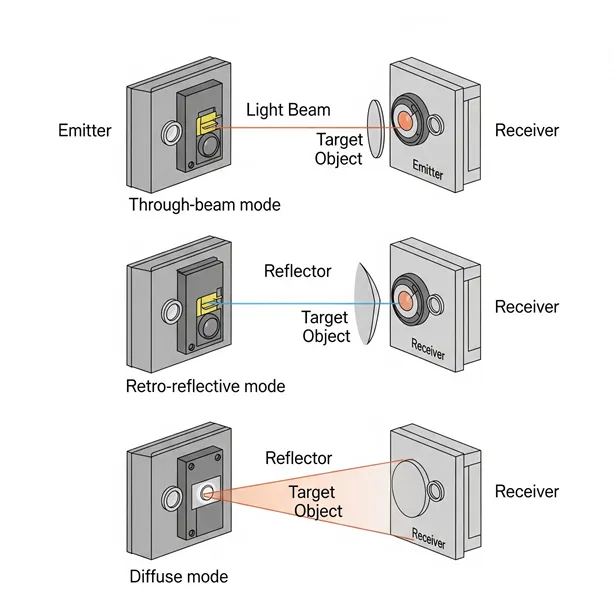What is a Proximity Switch (Sensor)? Types, Working Principle, Applications, and Sensing Range
Published on July 2, 2024 | Category: ProximityShare this Page:
A proximity sensor is a type of non-contact sensing device that detects the presence, absence, or movement of an object within its sensing range without any physical contact. Unlike mechanical limit switches, which rely on physical interaction with the target, proximity sensors generate an electrical signal when an object (also known as the 'target') enters their field of detection. These sensors operate based on several physical principles, such as electromagnetic induction (used in inductive sensors), changes in electrical capacitance (used in capacitive sensors), ultrasonic wave reflection, infrared light reflection, and magnetic field detection (reed switches).
Proximity sensors are widely used in industrial automation systems, robotics, safety systems, smart phones, packaging machinery, and automotive applications like self-driving vehicles. Depending on the type, they can detect both metallic and non-metallic objects and provide accurate, high-speed, and wear-free operation.
This page explains the core working principles of proximity sensors, their various types—inductive, capacitive, ultrasonic, photoelectric, and magnetic—their detection mechanisms, key features, sensing ranges, and practical applications. It also covers relevant global standards such as JIS C 8201-5-2 and IEC 60947-5-2, which define how proximity sensors are classified and tested. Understanding these concepts is essential for engineers, technicians, and automation professionals aiming to integrate smart and contactless detection systems into modern control processes.
What is a Proximity Sensor?
A proximity sensor is a non-contact sensor that detects the presence or absence of an object—commonly called a "target"—when it enters the sensor’s sensing zone. These sensors operate without physically touching the target, making them ideal for applications where contact could damage the object or sensor.
Depending on the sensor type, proximity sensors use electromagnetic fields, infrared radiation (IR), light, ultrasonic waves, or magnetic fields to detect objects. When the target is detected, the sensor converts this event into an electrical signal.
Proximity sensors are commonly used in a wide range of applications such as smartphones, recycling systems, self-driving vehicles, assembly lines, anti-aircraft systems, and more. Their high reliability, speed, and contactless nature make them essential components in modern automation.
What are Proximity Switches?
The term proximity switch is often used interchangeably with proximity sensor, but there is a subtle difference between the two. A proximity sensor is a non-contact sensing device that detects the presence of an object (target) within its range. In contrast, a proximity switch refers specifically to a sensor that actively opens or closes an electrical circuit based on the detection of a nearby object.
In simpler terms, while all proximity switches are sensors, not all proximity sensors function as switches. A proximity switch includes both the sensing element and the switching mechanism that controls the electrical signal output in response to the presence or absence of an object.
What is the IEC Standard for Proximity Sensors?
The International Electrotechnical Commission (IEC) has defined proximity sensors under the standard IEC 60947-5-2. This standard classifies non-contact position detection switches used in industrial control systems. It sets technical guidelines for testing, electrical characteristics, environmental resistance, and mechanical behavior of proximity switches.
IEC 60947-5-2 ensures that manufacturers follow a consistent design and performance level, making proximity sensors reliable for use in automation systems, machinery, and robotics.
What is the JIS Standard for Proximity Sensors?
In Japan, the Japanese Industrial Standards (JIS) define proximity sensors under the standard JIS C 8201-5-2. This standard is aligned with the IEC standard and specifically refers to low-voltage switchgear and controlgear — proximity switches. According to JIS:
- All non-contact sensors that detect nearby objects are considered proximity switches.
- It classifies proximity switches into different types, such as inductive, capacitive, ultrasonic, photoelectric, and magnetic.
This helps industries in Japan and internationally adopt proximity sensors with assured quality, compatibility, and safety.
Types of Proximity Sensors Recognized by Standards
- Inductive Proximity Sensors: Detect metal objects using electromagnetic fields.
- Capacitive Proximity Sensors: Detect both metallic and non-metallic objects by sensing changes in capacitance.
- Ultrasonic Sensors: Use high-frequency sound waves to detect targets.
- Photoelectric Sensors: Use infrared or visible light to sense object presence.
- Magnetic Sensors (Reed Switches): Detect magnetic fields or magnets for switching.
Advantages of Proximity Sensors
- Non-contact detection: Prevents mechanical wear and extends sensor life.
- High-speed response: Detects objects instantly, making them suitable for fast-moving systems.
- Longer lifespan: Most sensors use solid-state electronics with no moving parts.
- Reliable operation: Works well in harsh environments with dust, oil, moisture, or vibration.
Conclusion
Proximity sensors are crucial components in modern automation, offering fast, reliable, and contactless detection. Standards like IEC 60947-5-2 and JIS C 8201-5-2 ensure consistent quality and performance across different sensor types. Whether used as switches or sensors, they help industries improve safety, speed, and efficiency.
In summary, a proximity sensor is an essential component for detecting objects in industrial automation, safety systems, and consumer electronics—without ever making physical contact.
Types of Proximity Sensors
Proximity sensors are classified based on the principle they use to detect objects. Each type is suited for specific materials and environments. The most common types of proximity sensors include:
- 1. Inductive Proximity Sensor: Detects metallic objects using electromagnetic induction. When a metal target enters the magnetic field produced by the sensor, eddy currents are generated, which trigger the sensor output. These are commonly used in industrial automation for detecting iron, steel, aluminum, etc.
- 2. Capacitive Proximity Sensor: Can detect both metallic and non-metallic materials such as plastic, glass, wood, and liquids. It works by sensing changes in capacitance when a target comes near the sensor face. Widely used for level detection, object counting, and packaging lines.
- 3. Ultrasonic Proximity Sensor: Uses high-frequency sound waves to detect the presence of objects. It emits ultrasonic pulses and measures the time taken for the echo to return. Suitable for detecting objects at longer distances and in dusty or dirty environments.
- 4. Photoelectric Proximity Sensor: Uses a beam of light (usually infrared or visible) to detect objects. When an object interrupts the light beam, the sensor output is triggered. It can detect a wide range of materials and colors, and is used for counting, alignment, and object detection on conveyors.
- 5. Magnetic Proximity Sensor (Reed Switch): Operates by detecting magnetic fields. It includes a magnet and a reed switch, which closes or opens the circuit when the magnetic field is present. Often used in door sensors, security systems, and position monitoring.
What is a Capacitive Proximity Sensor?
A capacitive proximity sensor is a type of non-contact sensor that detects objects based on changes in capacitance. It can detect both metallic and non-metallic materials. When an object enters the sensing area of the sensor, it alters the capacitance between the sensor and the object. This change is used to trigger the sensor output.
The sensor is sensitive to any object that can store or affect an electrical charge. As a result, capacitive sensors can detect a wide range of materials including plastic, glass, wood, liquids, powders, and metals.

Working Principle of a Capacitive Proximity Sensor
Capacitive proximity sensors operate by generating an electrostatic field from their sensing face. When an object with a different dielectric constant (ability to hold charge) enters this field, the capacitance changes. The sensor continuously monitors this capacitance. When it crosses a certain threshold, the sensor output is activated.
The key factors that affect detection include:
- Distance between the sensor and the object
- Size and shape of the object
- Material and dielectric properties of the object
Common Applications of Capacitive Proximity Sensors
- Liquid level detection (through plastic or glass containers)
- Object presence sensing in packaging and bottling machines
- Detecting plastic parts, paper stacks, or powders
- Wood or glass detection in automated systems
Because of their ability to detect a wide variety of materials, capacitive proximity sensors are widely used in industrial automation, food and beverage industries, and material handling systems.
What is an Inductive Proximity Sensor?
An inductive proximity sensor is a non-contact sensor that detects the presence of metallic objects within its sensing range. These sensors are widely used in industrial environments to detect metal components on machinery, conveyors, or automation lines. They are designed to respond only to conductive materials like steel, iron, copper, and aluminum.
The key feature of inductive sensors is that they do not detect non-metallic objects like plastic, wood, or glass. This makes them ideal for metal detection tasks where speed, precision, and durability are required.
Working Principle of Inductive Proximity Sensors
Inductive proximity sensors operate based on the principle of electromagnetic induction. The sensor contains an oscillator that produces a high-frequency alternating magnetic field near the sensor's face (the active surface).

When a metallic target enters this magnetic field, it induces small circulating currents called eddy currents on the surface of the metal. These eddy currents create an opposing magnetic field, which causes a change in the energy of the original field.
This change in energy causes a drop in the amplitude of the oscillation within the sensor. The internal circuit detects this change in amplitude and triggers the sensor’s output, signaling that a metallic object is present.
Key Factors That Affect Detection Distance
- Type of metal: Ferrous metals like iron and steel have the highest detection range. Non-ferrous metals like aluminum or copper reduce the sensing distance.
- Size and shape of the target: Larger or thicker metal objects are detected from farther away.
- Sensor design and frequency: High-frequency sensors are more sensitive to small or thin targets.
Applications of Inductive Proximity Sensors
- Detecting position of machine parts
- Counting metal objects on conveyors
- Automated part ejection systems
- Monitoring gear rotation or camshaft position
Inductive proximity sensors are robust, fast, and resistant to dirt, oil, and moisture. These features make them ideal for harsh industrial environments where only metal detection is needed.
What is an Ultrasonic Proximity Sensor?
An ultrasonic proximity sensor detects the presence or distance of an object by using high-frequency sound waves. Unlike inductive or capacitive sensors, ultrasonic sensors can detect almost any material, regardless of shape, color, or transparency. These sensors are commonly used in level sensing, object detection, and distance measurement applications.

Working Principle of Ultrasonic Proximity Sensor
Ultrasonic sensors emit a burst of ultrasonic sound waves (typically above 20 kHz) from a transducer. When these waves strike an object, they reflect back to the sensor. The time taken for the echo to return is measured, and the distance to the object is calculated using the speed of sound. If the object is within the preset range, the sensor sends a signal.
What is a Photoelectric Proximity Sensor?
A photoelectric proximity sensor uses a light beam, typically infrared or visible light, to detect the presence or absence of an object. These sensors are highly versatile and can detect a wide range of materials, including transparent, colored, or reflective surfaces. They are ideal for long-range object detection and are widely used in packaging, conveyor systems, and automation.

Working Principle of Photoelectric Proximity Sensor
A photoelectric sensor consists of a light emitter and a receiver. The detection occurs when the sensor detects changes in the light received. There are three main types of photoelectric sensing methods:
- Through-beam: The emitter and receiver are placed opposite each other. The object is detected when it blocks the beam.
- Retro-reflective: Both emitter and receiver are on the same side. A reflector bounces the light back, and detection occurs when the object interrupts this reflection.
- Diffuse: The emitted light reflects off the object itself and returns to the sensor's receiver.
What is the Range of a Proximity Sensor?
The range of a proximity sensor refers to the maximum distance at which it can reliably detect the presence of a target object. This sensing distance depends on the sensor type, size, and the material of the object. Inductive sensors typically detect metallic targets within a range of 1 mm to 30 mm, while capacitive sensors can detect non-metallic objects at distances up to 50 mm or more. Ultrasonic and photoelectric proximity sensors offer extended ranges from a few centimeters to several meters, depending on the application.
Proximity Sensor Applications
Proximity sensors are highly versatile and can be used in a wide range of environments and industries. They are especially useful in any application where detecting the presence or absence of an object within a specific range is essential. These sensors operate reliably even in challenging conditions such as the presence of oil, water, dust, or fluctuating temperatures.
Common Application Areas
- Object position detection in automated systems
- Transportation, logistics, and supply chain automation
- Inspection and quality assurance in manufacturing
- Process control in industrial automation
- Liquid and solid level detection in tanks and containers
- Food processing and packaging systems
- Agricultural automation (e.g., seed detection, flow control)
One of the key benefits of proximity sensors is their ability to operate in harsh environments. For instance, they can function reliably where oil, water, or dust is present, offering an advantage over contact-based sensors or switches. Capacitive sensors, in particular, can detect a variety of materials based on their dielectric constant.
Target Materials Based on Sensor Type
- Capacitive Proximity Sensors: Suitable for detecting metals, water, liquids, resin, and powders
- Inductive Proximity Sensors: Detect metals such as iron, steel, aluminum, copper, and brass
- Magnetic Proximity Sensors: Used specifically to detect magnets or magnetic fields
Environmental Suitability
Proximity sensors are designed to work reliably in environments with fluctuating or extreme temperatures. Depending on the model, most proximity sensors can function in temperatures ranging from -50°C to +100°C. This makes them ideal for outdoor, industrial, and refrigerated applications.
What to Consider When Selecting a Capacitive Proximity Sensor
Choosing the right capacitive proximity sensor for your application is essential for reliable performance and accuracy. These sensors are used across a wide variety of industries, so selecting the best fit depends on understanding key technical parameters and environmental requirements.
Here are the most important factors to consider when selecting a capacitive sensor:
Key Selection Criteria
- Body Style: Available in barrel (cylindrical) or block (rectangular) housings. Choose based on space constraints and mounting preferences.
- Switching Output Type: Select between NPN (sinking) or PNP (sourcing) based on your control circuit wiring.
- Output Function: Choose Normally Open (NO) or Normally Closed (NC) outputs depending on how you want the sensor to behave when no target is detected.
- Detection and Sensing Range: Ensure the sensor’s range fits the distance required for your application. Capacitive sensors typically detect objects from 1–25 mm away.
- Target Type: Consider what the sensor will detect—liquids, powders, plastics, wood, or other non-metallic materials. The dielectric constant of the target affects sensing performance.
- IP Rating: The sensor's Ingress Protection (IP) rating determines its ability to resist dust and water. For industrial or washdown environments, choose IP65, IP67, or higher.
- Installation Type: Determine if the sensor is flush-mounted (embedded into a surface) or non-flush (protruding), which affects sensing distance and sensitivity.
- Shielding: Sensors can be shielded, partially shielded, or unshielded. Shielding controls the shape of the sensing field and helps avoid false triggering in metallic environments.
- Response Time: Choose a sensor with fast response time if used in high-speed processes such as counting, sorting, or packaging lines.
- Application Type: Consider whether the application is static (presence detection) or dynamic (moving targets), and the temperature or chemical exposure involved.
Selecting the proper capacitive sensor ensures accurate detection, minimal false triggers, and maximum efficiency in your automation system.